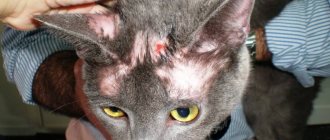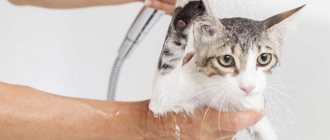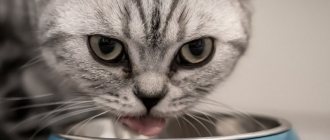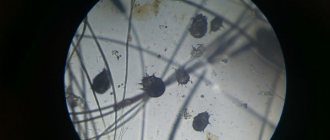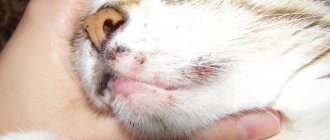Distemper in cats is a very serious disease that is fatal in 90% of cases. Another name for the disease is viral enteritis or panleukopenia. It is worth considering that the virus that causes distemper in cats is adapted to any negative influences. It is not afraid of the following factors: heating to a temperature of 60 degrees, freezing, disinfection. The virus has the unique ability to live in the external environment for a year.
Routes of infection
There are several factors that cause distemper infection in cats. The main path is contact. That is, when interacting with a sick animal. Moreover, the proximity of the contact does not matter. A cat can become infected by walking on the grass or eating food from an infected person’s bowl. This is because high concentrations of the virus are found in the cat's stool, nasal discharge or saliva. Consequently, any discharge into the outside world puts all cats without exception at risk of infection.
- Airborne droplets - when near a sick cat.
- Through parasites and insects: fleas, ticks.
- Through a person, the virus can enter the house on the clothes or shoes of any family member. No one is immune from the disease, so you should not ignore the protection of your pet, even if he lives only within the confines of the house without going outside.
It should be borne in mind that after recovery the animal remains a carrier of the disease for some time.
An unpleasant fact: in the house where the sick animal was, the virus is stored for 6 to 12 months. Therefore, during this time you should not get a new pet.
There is a high probability of infection with distemper in cats with weakened immune systems, after illness or stress. Adult cats are most often exposed to infection: their defenses are depleted, and the body cannot resist the penetration of viruses and infections. That is, the main risk group for infection with distemper in cats is animals aged 6 years and kittens up to one year. Moreover, the younger the cat, the less chance of survival. In case of intrauterine infection, kittens are doomed to death. There are certainly chances to survive. But most often kittens are born with defects.
Attention: this disease is unique to cats. The FFV virus does not attack humans or dogs.
The period of greatest activity of the virus occurs in the spring months. At this time, the pet owner should be extremely careful.
Distemper: how to deal with this cat disease
Cats are susceptible to many diseases. One of the most dangerous is plague (panleukopenia). This is a fatal disease that is important to recognize in time. If measures are not taken in time, 90% of cases end in death for the pet. Therefore, you should study the main signs of distemper in order to protect your cat from death. This viral disease is not dangerous for humans.
Risk group
Cats aged 6-8 years are most susceptible to the disease
Cats under 6 years of age are at the least risk of developing panleukopenia. Over the years, the animal's body becomes depleted. Its protective functions become weaker. And then plague infection becomes practically unhindered.
Cats aged 6-8 years are considered a high risk group. But the greatest danger of infection is in kittens and young animals under 1 year of age. If a pregnant cat gets sick, she miscarries, the cubs become nonviable or mummify.
Methods and ways of infecting cats with distemper
The virus that causes distemper enters the external environment along with the urine, feces, and saliva of sick cats, as well as those that have recovered from this disease. You can become infected with panleukopenia through hygiene items that come into contact with your cat.
Pets become infected after drinking from a container from which a sick animal drank, while walking on the street where a carrier of the virus was walking. It is not necessary to have close contact. Even if the animal has already been ill, the distemper virus can survive in the house for 6-12 months. After recovery, the cat is still considered a carrier of the virus.
It is possible that feline plague can be transmitted in utero or that it can be carried by blood-sucking insects. Humans can also carry the virus. But he himself does not suffer from the plague. The infection can be brought on by shoes or dirt particles on clothing. Unfortunately, it is impossible to get rid of the causative agent of the disease by disinfecting the premises - it is powerless against the virus.
Effect of the virus
When a virus enters an animal’s body, it affects all organs and systems (heart, bone marrow, lungs, lymph, etc.). After infection, external manifestations of the disease appear after 7 days.
In small kittens, symptoms are visible already on the second day. The pathogenic activity of the pathogen leads to dehydration of the cat's body. And this subsequently disrupts the functioning of the digestive organs, causing intoxication of the body and heart failure.
Forms of the disease
Distemper is a disease caused by a virus, therefore, like most viral diseases, it develops in several stages.
Super sharp or lightning fast
In young cats, the most common form of distemper is the hyperacute or fulminant form of distemper.
In most cases, it is observed in young animals under 1 year of age. This stage is characterized by the following signs:
- refusal to eat;
- trembling in the paws;
- very rapid weakening;
- the fur becomes matted and dirty.
If the causative agent of the disease affects the central nervous system, then signs similar to rabies may appear:
- fear of light;
- the cat is afraid of all sounds;
- is constantly near a container of water, but does not drink.
Later, yellowish foamy vomit appears. The stools are very offensive and contain a lot of blood. A small kitten may stop responding to its mother.
Acute stage
It affects mainly adults. It is characterized by the following symptoms:
- lack of interest in the outside world;
- difficulty breathing;
- greenish or yellowish foamy vomit;
- temperature up to 41°C, which then drops to 37°C;
- feces are watery.
After 1.5-2 days, the nature of vomiting changes. It becomes mucous, interspersed with blood . When a virus infects the respiratory system, a cat suffers from the following symptoms:
- presence of wheezing in the chest;
- redness in the eyes;
- cough;
- inflammatory red rashes on the skin, which can gradually fill with purulent exudate;
- hot nose
The animal is tormented by severe thirst, but it cannot drink due to severe pain. If not treated promptly, the cat's death can occur within a week. After a pet suffers from distemper, it remains immune to the disease for several years.
Subacute stage
Vaccinated and resistant cats are susceptible to this form of the disease. With proper therapy, the animal recovers quickly. The symptoms of the disease are quite sluggish. The course of plague does not exceed 2 weeks. The symptoms are the same as in the acute stage, but not as intense.
Diagnostics
At the first symptoms, you need to contact a veterinarian for help; the sooner a diagnosis is made and treatment is started, the higher the chance of recovery.
The veterinarian must gather as much information about the cat as possible to make a diagnosis. You must not miss out on details about the animal. You need to indicate when the cat last walked outside; when signs of illness appeared, etc.
After this, the doctor prescribes laboratory tests of blood and urine. The blood is sent for virological testing. If your cat has the distemper virus, a complete blood count will reveal an elevated white blood cell count. You also need to take your pet's temperature.
Treatment of plague
The panleukopenia virus is very persistent, and there is no effective single cure for it. Therefore, an integrated approach to the treatment of the disease is required. To do this, they use both etiotropic drugs to destroy the pathogen and drugs to relieve symptoms.
The antiviral drug Fosprenil is used more often. It is administered intramuscularly. For a cat weighing up to 1 kg, a single injection is 0.2 ml, 1-5 kg - 0.5 ml. Treatment should last at least 14 days. At first, 4 injections are given per day, gradually reducing to 1.
Enterostat 20 mg/kg is used once a day. The course lasts 7 days.
Symptomatic therapy for panleukopenia is aimed at reducing the signs of the disease.
Calcium chloride is used to prevent dehydration. To stop vomiting, the cat is given Regidron or Rieger. They can be diluted with glucose and a little soda added to the solution. During the day, the animal should drink an amount of 50 ml/kg.
To rid your pet's body of toxins, you need to give him diuretics. Decoctions of horsetail, bearberry, and lingonberry leaves are suitable. The cat must be given antibiotics throughout the entire treatment period, since the distemper virus causes secondary bacterial infection.
Vitamins and iron supplements (Ferrodextran, Ursoferran) must be included. To normalize metabolic processes, Catozal is prescribed for 7 days. To relieve spasm and pain, the cat is given Dibazol or No-shpa.
How to behave during treatment
It is necessary to disinfect and clean the room with a sick animal
Regularly during treatment, it is necessary to clean the eyes of pus with a cotton swab soaked in the drug, and quickly remove feces.
From time to time, the room where the animal is located should be ventilated. During ventilation, it is better to take the cat into another room. The air temperature should be comfortable.
It is necessary to periodically disinfect using a UV lamp or sodium hypochlorite solution. Wet cleaning of the room several times a day is also necessary. Avoid exposing the animal to direct sunlight.
Feeding during recovery
Distemper is a serious disease that requires careful care of the animal. This also applies to nutrition during the recovery period after illness. When the cat's appetite returns, it can only be given pureed, light food. Its temperature should be room temperature.
You cannot force feed your pet. He will start eating on his own when he feels better. Portions should be small. Small meals 5-6 times a day are recommended. Cottage cheese and low-fat broth work well. Later, you can introduce lean meat and fish into your diet. Vegetables, fruits and grains should not be given for 2 months after recovery.
Treatment of plague with vodka
Some people think that treating feline distemper with vodka is ineffective. But if veterinary care is not possible, this method of treatment can often save the animal from death.
You need to mix 1 spoon of vodka with 1 chicken yolk. Give a sick cat 2-3 times a day 1 spoonful of this product. Within a day, the results of this treatment may appear. Soldering with vodka is used only in the first 1-2 days after the virus is introduced into the animal’s body.
How to prevent the disease
To avoid disease, you need to vaccinate your pet.
It is better to prevent a disease than to treat it. The most reliable remedy against the distemper virus is vaccination. Kittens especially need vaccinations, as they are the most vulnerable individuals. They need to be vaccinated from 2 months of age. Repeated vaccination is given after 21 days. An adult animal requires annual vaccination.
Before the vaccination procedure, it is necessary to remove helminths from the animal’s body. Otherwise, the body, weakened by helminths, may give an unexpected reaction to the vaccine. Deworming is carried out no later than 2 weeks before the planned vaccination. It is not recommended to vaccinate a cat under stress, during illness, pregnancy and feeding.
with distemper within the last year All items that have been in contact with a sick pet must be destroyed or thrown away.
Consequences of the virus
A cat who experiences panleukopenia may experience undesirable consequences. Often the disease does not go away without a trace. The animal develops chronic diseases of the respiratory system, heart, and central nervous system. Some animals should eat only dietary products after suffering from distemper. They require special care throughout their lives.
Panleukopenia is a dangerous disease that is very difficult to treat. Often it can cause the death of a pet. Therefore, it is important to detect plague in time and begin treatment. But it is best to prevent it by getting vaccinated in a timely manner. The virus is very stable, so if there are other pets in the house, it is necessary to protect them from the disease.
Source: https://koti-koshki.ru/chumka-u-koshek-simptomi-i-lechenie.html
The effect of the virus in the cat's body
Having penetrated the body, the virus chooses blood as its initial target. As a result, the number of white blood cells drops sharply. Lack of therapy leads to progression of the disease. As a result, the functioning of the gastrointestinal tract, cardiovascular system, lungs and bone marrow, as well as lymphoid tissues is disrupted. After a certain period of time, the nervous system is affected. Causes leading to death: severe dehydration, heart failure, secondary infections that develop against the background of the disease.
Diagnosis of panleukopenia
The diagnosis of feline distemper is made taking into account the clinical picture of the disease, epizootic data and laboratory results. The veterinarian must rule out poisoning, foreign body entry into the digestive organs, acute toxoplasmosis, pancreatitis, feline leukemia, and immunodeficiency virus.
Examination by a veterinarian
The carcasses of dead cats are subjected to post-mortem examination. During the procedure, signs of severe dehydration are recorded, the small intestine is affected, and the lymph nodes are greatly enlarged. Signs of septicemia are found in the internal organs - spleen, liver and kidneys. Changes in lymphoid tissue are determined using a histological method. In some animals that die from panleukopenia, pneumonia, pancreatitis and laryngitis are confirmed.
Symptoms of distemper in cats
Having penetrated the body, the virus quickly damages organs and tissues. The incubation period is 7 days in adults; in babies, characteristic signs appear within a couple of days.
In order to save the animal, you need to quickly notice the symptoms of distemper in a cat and start treatment in a timely manner. In advanced forms, drug intervention will not help, and the cat faces death. Distemper in cats is divided into three types: fulminant, acute, and subacute. Depending on the type of panleukopenia, signs of the presence of the virus in the body may vary.
Lightning form
This type is typical for young pets from 2 weeks old. First of all, weakness and drowsiness appear, and the condition becomes more complicated every day. The peak becomes fever and complete disregard for food. The owner will notice an unhealthy appearance of the fur: it loses its shine and fluffiness, and becomes sticky. Over time, the virus strengthens in the body and affects the nervous system. The cat's behavior becomes inappropriate: it can rush around the apartment or hide in secluded corners. Light and harsh sounds are irritating. The owner may think that the animal has rabies. This is why timely diagnosis by a doctor is necessary, because it is difficult for a person without the appropriate education to distinguish between diseases with similar symptoms. Motor activity is reduced to zero. The animal can spend the entire day lying down. If treatment is not started immediately, more severe symptoms of distemper in cats will appear: diarrhea with blood clots and vomiting with foam.
Helpful information: Kitten distemper is fatal in most cases, and symptoms do not necessarily have to be present. A weak immune system is unable to resist the virus.
Acute form
In most cases it affects adults.
First signs:
- Decreased or lack of appetite;
- Drowsy depressed consciousness;
- Lack of desire to move and be active;
- Diarrhea and vomiting are yellow or green in color, after a while bloody clots appear;
- Temperature fluctuations: drops or rises;
- Complications of the cardiovascular system: cough, wheezing;
- Atypical discharge from the eyes and nose;
- The appearance of ulcers and redness on the skin;
- Increased dehydration.
If even a few symptoms appear, you should immediately go to the doctor. In rare cases, the animal is able to cope on its own. Most often, without the necessary course of treatment, the cat is doomed to death. But if it is possible to cure distemper in cats, then the animal has protection from re-infection for the coming years, and maybe even for life.
Treatment
It is strictly forbidden to try to cure your pet on your own. This is fraught with serious complications and the transition of the disease to a more serious stage. Only a doctor can prescribe a competent course of treatment after a thorough examination and test results. Having established the exact form of distemper in a cat, therapy will be prescribed that will lead the animal to recovery. There is no single course of treatment or any miracle cure for the disease; the doctor builds therapy based on the data of a particular animal.
The basis of treatment is:
- Drugs that maintain water-salt balance at an optimal level;
- Vitamins and glucose to strengthen the immune system;
- Antibiotics and antivirals;
- Painkillers and antiemetics.
Average duration of treatment: 1-2 weeks. The duration depends on the health status of the particular pet and the severity of the disease. Under no circumstances should you stop therapy without a doctor’s examination, even if it seems that the virus has been defeated. The end of the course of treatment is possible after re-diagnosis at the veterinary clinic. Otherwise, an animal that is not completely cured may catch the virus again, and the disease will begin in a new circle.
Prevention of feline distemper
photo from the site privivku.ru
Animal vaccination is gaining popularity. This is important because your pet will be more protected from environmental influences. As a rule, the main patients are kittens. Small animals need to be treated regularly for many diseases, and feline distemper is no exception.
It is important to know
Everything that a sick cat has touched must be thrown away if you plan to have another animal. Cats that have had distemper usually develop immunity to the disease.
Useful tips for a cat owner
If only a veterinarian can prescribe treatment, then every pet owner can create favorable conditions conducive to a speedy recovery.
- Regular ventilation. Do not leave the animal in a draft. During the ventilation period, it is advisable to take the cat into the next room.
- The room in which the cat is located must be darkened. It is advisable to protect her from loud sounds.
- Timely cleaning of the tray. Moreover, the main thing is not to forget about the personal hygiene of all family members, especially after cleaning up feces. Discharge from the eyes must be removed immediately with a cotton swab.
- A careful diet. During the treatment period, you need to monitor your pet’s diet. The food offered to the cat should be at room temperature and ground. In the first days, it is recommended to feed fermented milk products and low-fat broth.
- Detailed disinfection of the premises is necessary. To do this, it is best to use a solution of bleach in a ratio of 1:9 to water. Moreover, the walls, floor, and all secluded places should be treated. Particular attention should be paid to personal hygiene items.
Attention: There is no need to encourage your cat to eat. Over time, the appetite will improve and the animal will return to its usual diet. Recommended dosage: several times a day in small portions. Veterinarians advise sticking to the diet for three months after complete recovery. This is necessary in order to set up the normal functioning of the gastrointestinal tract. For 2-3 months after complete recovery, you should not include greens, cereals and vegetables in the cat’s menu.
Apartment disinfection
The panleukopenia virus is very tenacious. In the apartment where the sick animal was located, virions remain viable for up to 12 months. Treating floors and furniture with conventional disinfectant solutions in most cases turns out to be ineffective.
quartz lamp
The best way to destroy pathogenic microorganisms is to quartz the room. Lamp exposure time is 20–25 minutes. At the end of the procedure, it is necessary to ventilate the room well.
Attention! During quartzing, you cannot be indoors, since exposure to radiation releases ozone, a very powerful oxidizing agent that is highly toxic.
Cat's water and food bowls should be washed morning and evening with a baking soda solution. The pet's bed is treated with formaldehyde gas. The floor in the room where a cat with distemper is located is washed 2 times a day. Stool and vomit are removed immediately. It is recommended to ventilate the room in the morning and evening for at least 15 minutes, during which time the animal is transferred to another place.
Treating distemper in a cat at home
Many people are in no hurry to seek qualified help when the first symptoms of distemper appear in cats. Everyone wants to cure their pet as soon as possible without drug intervention. Numerous reviews and advice from experienced cat owners indicate that treatment of this disease with folk remedies is possible. They claim that vodka will help cope with distemper in cats. Proven recipe: 1 tablespoon of vodka is mixed with the yolk until a homogeneous consistency is formed. Recommended dose: 1 tablespoon three times a day. If you decide to start treatment with vodka, you should understand that you can expect a positive result in the case of a mild form of distemper in cats or in the first days of infection, when the virus has not had time to spread to organs and tissues.
Remember: your pet's life is at stake. Is it worth ignoring the help of qualified specialists in order to try a folk recipe? After all, in this case no one gives any guarantee of recovery.
Forms of the disease
The hyperacute form appears in cats at an early age. The main symptoms are refusal of water and drinking. You can pay attention to this if the animal is constantly near water but does not drink at all. This is a spasm that affects the animal's larynx and prevents it from drinking normally. Trembling in the paws is also an indicator. Be sure to pay attention to these symptoms. You may also notice a fear of light and possible yellow, foamy vomit.
photo from murkote.com
This happens when the central nervous system is damaged. In very young animals, abandonment of their mother is observed. The child stops responding to it and is completely abstracted. After some time, you may notice an improvement in the cat's condition and calm down, but after a while your pet will die. This happens quite early.
note
If you notice the first symptoms - bulging eyes, refusal to eat and loose stools, contact your veterinarian immediately. Your pet is sick, but it can still be saved.
- Acute stage. Your animal begins to behave passively, stops drinking, goes to the toilet waterily and spends a lot of time with the drinking bowl, but practically does not drink - this is the acute stage. Can lead to death within a week, without timely assistance. After some time, the temperature may drop, but this is a bad sign. Your cat could die in no time.
After some time, the nature of the disease changes. The course is accompanied by wheezing and coughing. The stool is bloody, and when you palpate the abdomen, you may find inflammation of the lymph nodes.
- Subacute stage. The symptoms are absolutely similar to the acute stage. However, the course of feline distemper lasts two weeks. It usually develops in vaccinated cats and does not pose any particular danger.
Preventive measures against infection
If a person owns several cats and one of them has been diagnosed with distemper, then the rest should be urgently isolated. After this, it is recommended to wait for the incubation period, about three weeks to be on the safe side, and vaccinate all cats. Every owner should understand that it is impossible to completely eliminate the possibility of infection of a pet. However, regular vaccinations can protect your pet from serious illness. That is, it will minimize the risk of infection. Today there are vaccines whose action is aimed at stimulating immunity. They are absolutely safe for the health of the animal.
Useful information: cats that have reached adulthood need vaccination once a year. Before the procedure, deworming and confidence in the pet’s health are necessary. There is a list of contraindications due to which vaccination can only cause harm: pregnancy, lactation, weakened immunity, teething.
Kittens are ready for vaccination 9 weeks after birth, but revaccination is mandatory after 21 days. It is important to understand that vaccination must be regular. The following vaccines are trusted: Nobivak, Quadrikat, Multifel.
Is treating plague with vodka effective: a veterinarian’s opinion
Some cat owners, when symptoms of panleukopenia are detected, treat their pets with vodka or fortified wine. The yolk of a domestic chicken egg is mixed with 20 g of vodka and the animal is fed with this mixture 2-3 times a day. The product is poured into the mouth from a syringe, removing the needle, 4 ml each.
Experts warn against such actions because the already damaged intestinal mucosa will be burned by ethanol. In addition, alcohol further suppresses your pet's immune system.
Treatment of plague with vodka
There are known cases of animals recovering after using vodka for panleukopenia. Veterinarians explain them this way: improvement in the condition and disappearance of distemper symptoms after drinking strong alcoholic beverages occurs in animals with a stable immune system. That is, they most likely would have recovered without using vodka.
Consequences after the disease
Successful recovery does not guarantee that the animal will not have health problems in the future. After an illness, there is a high probability of developing chronic inflammation of internal organs and systems. However, it’s up to the cat’s owner to do everything, because it’s possible to prevent the problem with three simple steps:
- Timely vaccination;
- Preventive examination at a veterinary clinic, especially if any symptoms are observed;
- Careful care for your pet: good nutrition and comfortable living conditions.
Risk group
Clinically healthy animals under 6 years of age are least at risk of becoming infected with distemper, as statistics prove.
Over time, the protective functions of the animal’s body are depleted, which is why cats 6–8 years old are most often at risk of developing the disease. This group also includes young cats (up to 12 months) . At this time, the animal’s body is not yet strong. He cannot protect himself from the plague virus.
A cat infected during pregnancy produces nonviable offspring. Distemper can provoke fetal resorption, mummification and miscarriage.
Diagnosis of feline distemper
Only a veterinarian can diagnose the disease. Why is a cat's feces, urine and blood analyzed? Sometimes nasopharyngeal lavage is also examined. By the way, a stool test can show the presence of the virus already on the first day of infection. Therefore, when suspicions arise about a cat’s health, experts advise immediately contacting a veterinary clinic.


